A Guide To Diamond Shapes & Cuts
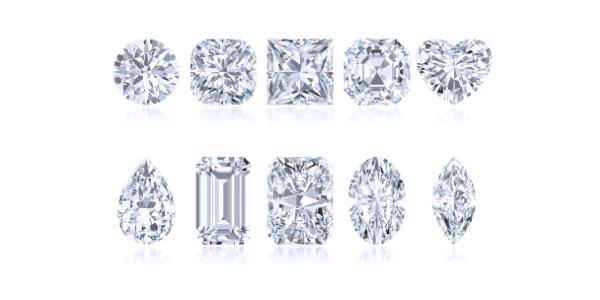
When shopping for diamond jewellery, the first decision that is usually made is the shape of the diamond. Typically there are 10 shapes to choose from; from the most popular round shape, to what are known as ‘fancy shapes’ like heart or pear shapes.
There are various things to consider when choosing your diamond shape, as each one offers something unique and wonderful and there are different advantages to each.
We’ve prepared a handy list of the most popular diamond shapes below, to help you select the perfect diamond. If you need further help, then why not book an appointment at one of our showrooms or contact one of our experts and we’ll be happy to assist you.
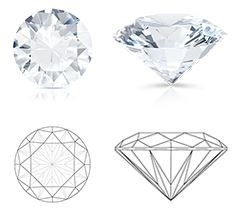
Round Brilliant Cut Diamond
This shape accounts for over 50% of all diamonds sold today.
Round is the most popular shape used for an engagement ring, and is the most versatile for the different engagement ring styles. With 58 facets carefully cut into the diamond, it achieves the maximum brilliance and offers a perfect reflection and refraction of light. The unique way that a round diamond is cut ensures the optimum movement of light through the stone which gives it the most scintillation of all the diamond shapes.
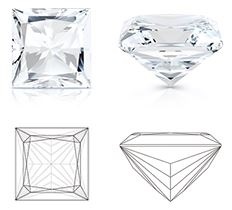
Princess Cut Diamond
The most popular of the fancy shapes, Princess Cut diamonds are also known as square cut diamonds.
As a relatively modern diamond shape, princess cut diamonds have only existed in their current form since the 1960s. These perfectly right angled shapes are essentially a square version of the round brilliant cut, and their technical name is a square modified brilliant cut. Usually cut with 57 facets, they provide exceptional sparkle and brilliance when set in an engagement ring and are a wonderful alternative to the round cut.
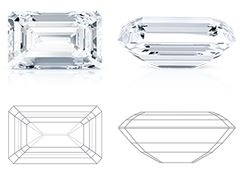
Emerald Cut Diamond
Originally a cut created for emerald gemstones, an emerald cut diamond is known as a step cut.
Unlike shapes such as round and princess, the unique step cuts of an emerald diamond showcase the purity and clarity of the stone. The long facets produce more dramatic flashes of light than a traditional sparkle like other shapes. The emerald cut shape is rectangular with cut corners, and is one of the most elegant and sophisticated diamond shapes. When choosing an emerald cut diamond, we recommend selecting a Clarity grade of VS2 or above.
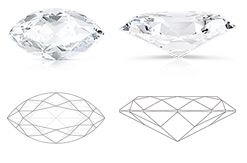
Marquise Cut Diamond
Commissioned by Louis XIV in France, this shape was inspired by the smile of his mistress and lover.
Whilst the style originated in the 1700s, it wasn’t until the 20th century that the shape was perfected to give us the sparkle we know today. As a variation of the round brilliant cut, it features two pointed ends at the top and bottom of the stone. A marquise diamond is beautiful when used as a solitaire or when enhanced by smaller diamonds. It also helps to elongate fingers if the wearer has smaller hands.

Pear Shape Diamond
Pear shaped diamonds are often called ‘teardrop’ diamonds because of their individual shape.
In order to get the perfect pear shape, the recommended ratio of the stone is between 1.5 and 1.7. This guarantees a nice full shape that isn’t too narrow and ends with an ideal and even point. With 56 to 58 facets cut carefully into the stone to optimise the light reflection and sparkle, this diamond shape offers a wonderful option for your engagement ring. A pear shape is a little shallower than other fancy shapes, which means you will get much bigger measurements with a pear than with a round or princess cut for example – offering great value for money.
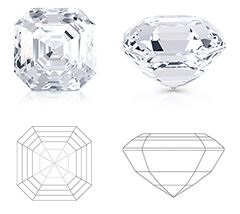
Asscher Cut Diamond
Developed by Joseph Asscher in 1902, asscher cut diamonds were a highlight of the art deco era.
It is often referred to as the ‘square emerald cut’ – because of its wide step facets and cropped corners cut to a perfect square shape. With their distinctive facet structure they highlight the natural beauty of a diamond beautifully and lend themselves better to higher qualities of diamond. At the height of the art deco era of the 1920s they really came into their own – being featured in many jewellery collections. Following the release of the film Great Gatsby in 2013, a resurgence of the stone for engagement rings began.

Oval Cut Diamond
The oval cut diamond part of the brilliant cut family elongated into an oval shape.
Since the 1960s, the modern day oval cut has been a magnificent addition to engagement rings. This elongated shape offers a wonderful spread of sparkle without blowing the budget. The alignment of its 58 facets sometimes causes a bow tie effect within the middle of the stone – an exclusive appearance only seen within an oval shaped diamond. These stunning diamonds work beautifully in a solitaire engagement ring as well as more elaborate designs like halo rings.
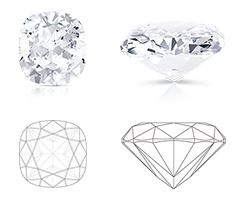
Cushion Cut Diamond
A square or rectangular shape with rounded corners, the cushion cut is so-called as it resembles a pillow.
Originally cut in the 19th century, it has become a firm fixture in engagement rings across the 20 years as it offers great value per carat compared to other diamond shapes. Usually comprised of 58 facets this sparkling stone can sometimes have what is known as a crushed ice effect. At Purely Diamonds, we tend to use square cushion cut stones as standard, but you can contact us directly if you’re looking for a more rectangular stone.

Heart Shape Diamond
This beautiful heart shaped diamond is considered the ultimate gesture of love and devotion.
A heart shaped diamond is usually comprised of between 56 and 58 facets, and is considered one of the most romantic choices, having been used in diamond jewellery for over 200 years, although we were first shown heart shapes as early as the 1600s. Whether set in a solitaire setting or complemented with side stones, the beauty of this stone speaks for itself and is the perfect option for those looking for a more unusual fancy shaped diamond.